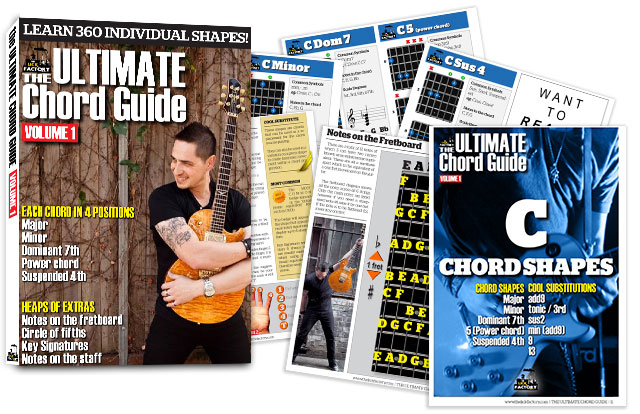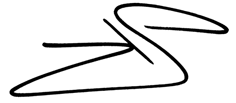THE ULTIMATE CHORD GUIDE: Volume 1
This is not your average, everyday chord book...

The ULTIMATE CHORD GUIDE – Volume 1 is not just any chord book. It is the first step in developing a completely new approach to chordal playing and chordal improvisation. The aim of the guide is to provide the reader with:
1. Multiple voicings for each chord
2. Provide some alternate chords that can be used as replacements for standard chords and shapes
The Guide draws upon key elements that you learn in our courses to give you an easy to understand library of shapes in every key. Each chord has 4 positions to play with an additional 2 shapes known as "Cool Substitutions" that can be used instead of the chord. The book gives you the necessary chords to start playing most contemporary songs immediately. Each chord is easy to find, separated by chord, then type. Volume 1 covers five types of chords. These chords are:
Each chord type also shows you the Common Symbols used for it when charted. You are also provided with the notes contained within it, as well as its scale degrees.
To help out with some of the theory knowledge, we've also included detailed articles taken from our Preliminary Lessons course which includes:
Available in a PDF E-book, the ULTIMATE CHORD GUIDE – Volume 1 is easy to carry around on your laptop or mobile device to ensure you have it when you need it.
Read, Learn and Play... It all starts with the ULTIMATE CHORD GUIDE.

A message from Kris...
Chordal improvisation is an important part of my playing technique. I found that over the years of playing, my ear got to a point where I’d be constantly looking for new sounds that could replace chords that I’d known since day 1.
What I found myself doing is replacing chords in a progression with others that would gel better within a song context. For example on a D – G – A progression, I might play Dsus2 – Dsus4 – G – Gsus2 – Asus4 – Asus2.
This would create a moving melody line within the chord shapes while trying to minimise movement between the remaining chord tones. To me, I found this unified chord progressions that I was playing better without sacrificing the overall tonality and key centre of the song.
I have been constantly asked by students how I approached this technique, and it’s a hard one to answer. I never do the same thing twice. I tend to adjust the chords I play to each and every song every time I play it. I listen to whats happening and take into account every other instrument including the vocals during each unique performance. I would then adjust my choral approach appropriately.
The I more I thought about it, this approach to chords wasn't a technique so to speak. To pass this onto a student, I would need to teach them to develop the thought process, and then the skills they would need to adapt on the fly.
So where would I start?
I singled out two things that a player must know to be able to execute this skill.
1. They would need to know each chord in as many positions as possible.
2. They would need to know what chords are available, when substituting chords in a progression.
The fundamental aim in writing the ULTIMATE CHORD GUIDE: Volume 1, was to provide a stable foundation for developing these 2 key skills.
In the book I start by giving you 4 positions to play the main types of chords in every key.
These chords are Major, Minor, Dominant 7th, 5 (power chord) and the Suspended 4th.
On-top of the 4 positions, I have also given you two of my favourite chords that I use as substitutes. Now this list is literally endless but this is definitely a good starting point for Volume 1.
So grab your guitar, your favourite song and start experimenting!

Some of the great features
360 individual shapes
There is definitely no shortage of shapes here! Each one is easily read, and can be used in practical chordal improvisation scenarios. You will expand your chordal knowledge here!
Over 70 pages of content
Each page of the ULTIMATE CHORD GUIDE: Volume 1 is packed full of content. It takes as many pages as it takes for us to give you the content we want to deliver.
5 Chord Types for every key
We cover off on the main types of chords that you will find in modern contemporary music. These are Major, minor, Dominant 7th, 5 (Power Chord) and the Suspended 4th.
4 positions of each chord in all keys
There is definitely no shortage of shapes here! Each one is easily read, and can be used in practical chordal improvisation scenarios. You will expand your chordal knowledge here!
2 Cool Substitutions per chord in all keys
To begin the process of replacing chords on the fly, we give you 2 additional chords for each shape. These 2 chords can be used as replacements at anytime for the chords they fall under.

